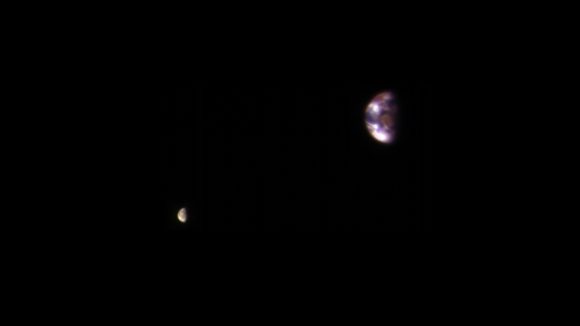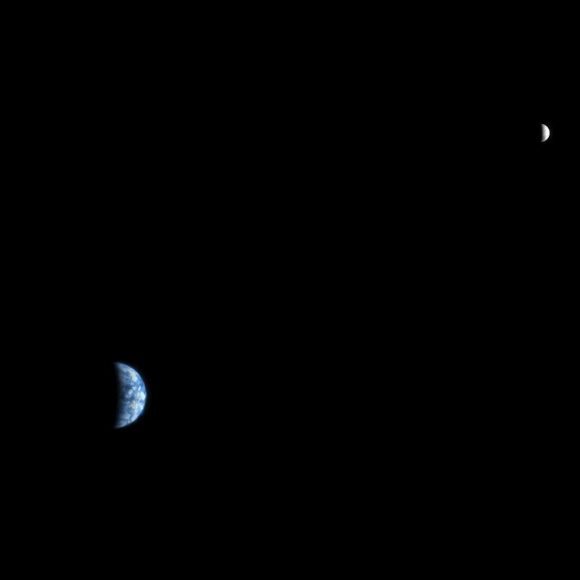The incredible HiRISE camera on board the Mars Reconnaissance Orbiter turned its eyes away from its usual target – Mars' surface – and for calibration purposes only, took some amazing images of Earth and our Moon. Combined to create one image, this is a marvelous view of our home from about 127 million miles (205 million kilometers) away.
Alfred McEwen, principal investigator for HiRISE said the image is constructed from the best photo of Earth and the best photo of the Moon from four sets of images. Interestingly, this combined view retains the correct positions and sizes of the two bodies relative to each other. However, Earth and the Moon appear closer than they actually are in this image because the observation was planned for a time at which the Moon was almost directly behind Earth, from Mars' point of view, to see the Earth-facing side of the Moon.

A view of Earth and its Moon, as seen from Mars. It combines two images acquired on Nov. 20, 2016, by the HiRISE camera on NASA's Mars Reconnaissance Orbiter, with brightness adjusted separately for Earth and the moon to show details on both bodies. Credit: NASA/JPL-Caltech/Univ. of Arizona.
"Each is separately processed prior to combining (in correct relative positions and sizes), so that the Moon is bright enough to see," McEwen wrote on the HiRISE website. "The Moon is much darker than Earth and would barely show up at all if shown at the same brightness scale as Earth. Because of this brightness difference, the Earth images are saturated in the best Moon images, and the Moon is very faint in the best (unsaturated) Earth image."
Earth looks reddish because the HiRISE imaging team used color filters similar to the Landsat images where vegetation appears red.
"The image color bandpasses are infrared, red, and blue-green, displayed as red, green, and blue, respectively," McEwen explained. "The reddish blob in the middle of the Earth image is Australia, with southeast Asia forming the reddish area (vegetation) near the top; Antarctica is the bright blob at bottom-left. Other bright areas are clouds. We see the western near-side of the Moon."
HiRISE took these pictures on Nov. 20, 2016, and this is not the first time HiRISE has turned its eyes towards Earth.
Back in 2007, HiRISE took this image, below, from Mars' orbit when it was just 88 million miles (142 million km) from Earth. This one is more like how future astronauts might see Earth and the Moon through a telescope from Mars' orbit.

An image of Earth and the Moon, acquired on October 3, 2007, by the HiRISE camera on NASA's Mars Reconnaissance Orbiter. Credit:
NASA/JPL-Caltech/University of Arizona.
If you look closely, you can make out a few features on our planet. The west coast outline of South America is at lower right on Earth, although the clouds are the dominant features. In fact, the clouds were so bright, compared with the Moon, that they almost completely saturated the filters on the HiRISE camera. The people working on HiRISE say this image required a fair amount of processing to make such a nice-looking picture.
You can see an image from a previous Mars' orbiter, the Mars Global Surveyor took of Earth, the Moon and Jupiter -- all in one shot -- here.
See this JPL page for high resolution versions of the most recent Earth/Moon image.






No comments:
Post a Comment